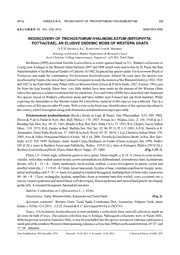
Rediscovery of Trichostomum hyalinoblastum (Bryophyta: Pottiaceae), an Elusive Endemic Moss of Western Ghats PDF
Preview Rediscovery of Trichostomum hyalinoblastum (Bryophyta: Pottiaceae), an Elusive Endemic Moss of Western Ghats
2013) DANIELS & AL, : REDISCOVERY OF TRIGHOSTOMUM HYALINOBLASTUM 205 NELUMBO 85: 205-206, 2018 Ish 0876 5068 REDISCOVERY OF TRICHOSTOMUM HYALINOBLASTUM (BRYOPHYTA: POTTIACEAE), AN ELUSIVE ENDEMIC MOSS OF WESTERN GHATS. AED. DANIELS, KC. KARIVAPPA AND R.SREEBHA Bayvlogy Laboratory, Botany Deparment & Research Centre Scott Cristian College (Autonomous), Nageroll - 629 O03, Tall Nadu Brotherus (1899) described Totella hyalinoblasta a anew species based on TL. Walker's collections in (Coorg (now Kodagu) in the Wester Ghats between 1897 and 1898 which were set to him by D. Pra, the then ‘Superintendent ofthe Botanical Garden of Calcutta. In 1902, he placed the species under Trichostomum Bruch of Pottiaceae and made the combination Tichostomum hyalinoblastum, Almost 26 years Inter, the species was recollected by Foreau (the las ofthe Colonial Europeans to study the mosses ofthe Western Ghats) in 1924, 1926 and 1927 in the Pala ils (now Palani Til) in Western Ghats (Dixon & P dela Varde, 1927; Freau, 1961), not {ar fom the type locality. Since then, very litle studies have been made on the mosses ofthe Western Ghats ‘where this species is seldom mentioned but for checklists. Aziz and Vohra (2008) have described and illustrated this species based on Walker’ collections alone and have nether scen Forea's nor any fresh material. While ‘exploring the Anamalas in the Wester Ghats fora bryoflor, material ofthis species was collected. This is & rediscovery ofthis species after 85 years. With view to facilitate easy identification of this species elsewhere in the country, a brief description along with illustration and distribution map is provide. ‘Trichostomum hyalinoblastum (Broth.) Broth. in Engl. & Prantl, Nat. Planzenfam. 1(3): 394. 1902; Dixon & P. de la Varde in Arch. Bot. Bull. Mens.1: 178, 1927; Foeau in J. Madras Univ. 2: 246, 1930 & in J. Bombay Nat Hist. Soc. 58:23, 1961; Bruchl in Rec. Bot, Sur. India 131): 37,1981; RS. Chopra, Taxon, Indian Moss. 130. 1975; RLH, Zander in Bul. Bufalo Soc. Nat. Si. 32:90, PL.13,f 1-5. 1993; AED. Daniels in R. ‘Annamalai, Tamil Nadu Biodivers. 57.2004 & in Arch, Bryol. 65:92. 2010; J. Lal, Checklist Indian Moss. 138. 2005; Aziz & Vota, Potiacese(Musci of India: 94, 34.2008. ortellahyalinblasta Broth in Ree. Bot. Suv India 1(12): 318. 1899. Symypes: India South Coorg (Kodagu), on trunks of trees in jungle, Jan. 1898, Walker 208 (CAL); tees in Bamboo forest near Pollebeta, Walker 219 (CAL); tees at Ponnapet, Walker 239 (CAL). ‘Barbulahyalinoblasa (Broth) Pars, Index Bryol. Suppl: 25.1900. Fig. 1;PLA) Plants 1.5-3.0mm high, yellowish-greento olive-green. Stems simple. 0.14 -0.16mm inross section, circular, with thin-walled central strand; cortex and medulla not differentiated; sclerodermis fain; hyalodermis absent; cells 4 - 12 x 6- 14um, moderately thick-walled, reddish, Leaves erectopatent to patent, curled and {rolled when dry,2~3 x 0.45 -0.53mm,linea-lanceolate, hyaline at base, renulae-pepillose at margin, acute; pica and median cells -8 <4 ~6um, hexagonal to rounded-bexagonal,mulipapllate on both sides; basal ones 40-60 x 8 -12um, rectangular, hyaline, epapllate, those at extreme base thin-walled; costa excurrent into a ‘ucro; ventral epidermis and stereid band well-developed; dorsal epidermis and stereid band poorly developed; guide cell 4, rounded-hexagonal, Sporophyte not sen, Habitat: Conticolous, on Cofea arabical..c. 825m. Distribution : India, Western Ghats: Karnataka and Tail Nadu, (Fig.2) ‘Specimen examined : Wester Ghats, Tamil Nadu, Coimbatore Dist, Anamalais, Valparai Taluk, Anali Extate,c. 825m, 128.2012, ED. Daniels & K.C. Kariyappa 8814p p.(SCCN). [Notes :Trichostomum hyalinablastum is most probably a corticolous form since all collections made so {ar were on bark of trees. The earliest collection was in Kodagu. Subsequent collections were in Palani Fils ‘With he present recordin Anamala ill, tay be concluded thatthe species is narrow endemic confined toa small part of the southeen Westem Ghats spanning a distance ofless than 200km north-south between 10°07" and 11°58" latitudes. Dae ofpbtewin 30 Deonbe, 2013 Rese 22.042018 + Ape 25082013 ‘© Savy on 2013 208 NELUMBO Dots 0.1 mm Fig. L: Dichosomum hyalinolaston (rah ean lis Ft etn ls GLa aa tis He etn hyn eo Leb ‘eat & KavappatB\epp) Plate 1: Thorton secon ea A WLet apis © Lesfecdin ote Le median ele cing popes Lentil al, ‘Tietimes Ke Lentidal cls Lebar cels 208 NELUMBO vols J av <\ ay [fry fafa — wee apes a, resoxt “ oral weer wont Vy ig. Dstrtin of Pchostoman allo blasn (Br) Bro "Starer locate + Presntoclty Clesring natural forests to introduce monoculture plantations such as coffee, te8, Cinchona, Eucalypus, el, and establishment of Hill Stations started as carly a8 19° century in Kodagu, Nigiri Hills, ‘Aoamalai il and Palani il during the Colonial Europea ra, Thus, the high-ltude mountain anges oF the southern Wester Ghats have suffered destruction of forests for more than two centuries, Hence it isnot tard for onto imagine the enomity of deforestation and the resultant loss of habitats making the survival of comticolous species such as Trchostomum hyalinoblastum al the more difficult and elusive for bryologists. ‘The present collection was made in an abandoned coffee plantation in Anali Estate. Needless to say that this, specesisa critically endangered one unless and ut itis collected elsewhere ina bryogeographicel region of ‘hecounty or globe. ACKNOWLEDGEMENTS ‘The senior authors thankful tothe Department of Science and Technology, New Dethi, forthe financial assistance. The authors are thankful to the Manager, Anali Estate, for permission to explore the area for bryophytes and the Principal, Sett Christian College, for facilites. REFERENCES. ‘Aziz, MIN. &IN. Vous 2008, Pttiacea Musi ofTnia,Bishen Singh Mahendra Pal Singh, Dehra India, ‘BROTHERS, VE. 1899, Contribution to the byological Hora of southem India. Report on the collection made by De TL, Wakerin Coorg uring the cold weather of 1897-98, Rec. Bot Sur India (12) 311-329, DIXON, HNN. & Pir dela Vado, R. 1927. Contribution flor byologique dnd merdionale Arch Bot. Bull Mens. 1161-184, FonéAtG. 1961, The moss ora ofthe Pani Hl. J, Bombay Nat, Hist Sac. 88: 13-47
